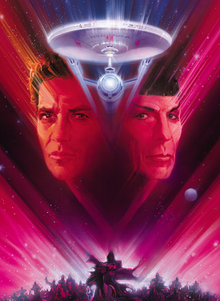
Back Star Trek V: The Final Frontier AN ستار تريك 5: الحدود النهائية Arabic Стар Трек V: Последната граница Bulgarian Star Trek: L'última frontera Catalan Star Trek V: Nejzazší hranice Czech Star Trek V: The Final Frontier Welsh Star Trek V: The Final Frontier Danish Star Trek V: Am Rande des Universums German Σταρ Τρεκ Νο 5: Τα Tελευταία Σύνορα Greek Star Trek V: La última frontera Spanish
| Star Trek V: The Final Frontier | |
|---|---|
 Theatrical release poster art by Bob Peak | |
| Directed by | William Shatner |
| Screenplay by | David Loughery |
| Story by |
|
| Based on | Star Trek by Gene Roddenberry |
| Produced by | Harve Bennett |
| Starring |
|
| Cinematography | Andrew Laszlo |
| Edited by | Peter E. Berger |
| Music by | Jerry Goldsmith |
Production company | |
| Distributed by | Paramount Pictures |
Release date |
|
Running time | 106 minutes[1] |
| Country | United States |
| Language | English |
| Budget | $33 million[2] |
| Box office | $70.2 million[3][4] |
Star Trek V: The Final Frontier is a 1989 American science fiction film directed by William Shatner and based on the television series Star Trek created by Gene Roddenberry. It is the fifth installment in the Star Trek film series, and takes place shortly after the events of Star Trek IV: The Voyage Home (1986). Its plot follows the crew of the USS Enterprise-A as they confront renegade Vulcan Sybok, who is searching for God at the center of the galaxy.
The film was directed by cast member William Shatner, following two films directed by his co-star Leonard Nimoy. Shatner developed the initial storyline, in which Sybok searches for God but instead finds a devil; his primary inspiration was the phenomenon of televangelism and the high potential for fraud among its practitioners. Series creator Gene Roddenberry disliked the original script, while Nimoy and DeForest Kelley objected to the premise that their characters, Spock and Leonard McCoy, would betray Shatner's James T. Kirk. The script went through multiple revisions to please the cast and Paramount Pictures, including cuts in the effects-laden climax of the film. Despite a Writers Guild strike cutting into the film's pre-production, Paramount commenced filming in October 1988. Many Star Trek veterans assisted in the film's production; art director Nilo Rodis developed the designs for many of the film's locales, shots, and characters, while Herman Zimmerman served as its production designer. Production problems plagued the film on set and during location shooting in Yosemite National Park and the Mojave Desert. Because effects house Industrial Light & Magic's best crews were busy and would be too expensive, the production used Bran Ferren's company for the film's effects, which had to be revised several times to lower production costs. The film's ending was reworked because of poor test-audience reaction and the failure of some planned special effects. Jerry Goldsmith, composer for Star Trek: The Motion Picture, returned to score The Final Frontier.
The Final Frontier was released in North America on June 9, 1989. It had the highest opening gross of any Star Trek film at that point and was number one in its first week at the box office; however, its grosses quickly dropped in subsequent weeks. The film received generally mixed to negative reviews by critics on release, and, according to its producer, "nearly killed the franchise". The next entry in the series, Star Trek VI: The Undiscovered Country (1991), received a much more positive reception.
- ^ "Star Trek V — The Final Frontier (PG)". British Board of Film Classification. July 6, 1989. Archived from the original on January 28, 2015. Retrieved May 22, 2013.
- ^ "10 Things You Might Not Know About Star Trek V: The Final Frontier". Warped Factor – Words in the Key of Geek. Archived from the original on August 31, 2019. Retrieved August 31, 2019.
- ^ "Star Trek V: The Final Frontier". The Numbers. Archived from the original on July 16, 2020. Retrieved March 12, 2024.
- ^ Eller, Claudia (December 11, 1998). "Lower Costs Energize 'Trek' Film Profits". Los Angeles Times. Archived from the original on November 18, 2020. Retrieved May 21, 2020.